Nigerian Finder

Queen Elizabeth’s Visit to Nigeria: History & Details
An important part of the history of Nigeria is her colonial story. Under colonialism and under the administration of Britain, the Queen (Queen Elizabeth) was the highest monarchical authority who was in control of government affairs. She carried out ceremonial functions in her position as head of state in the colonised Nigeria. She was also the monarch of the other common wealth realms, including the United Kingdom.
Even when Nigeria gained her independence in 1960, the Queen still held a high and important status in Nigeria. Queen Elizabeth was Queen of Nigeria from 1960-1963, the time between the nation’s independence and when she became a republic. You can see now the reasons her visits to Nigeria were always with such great fuss.
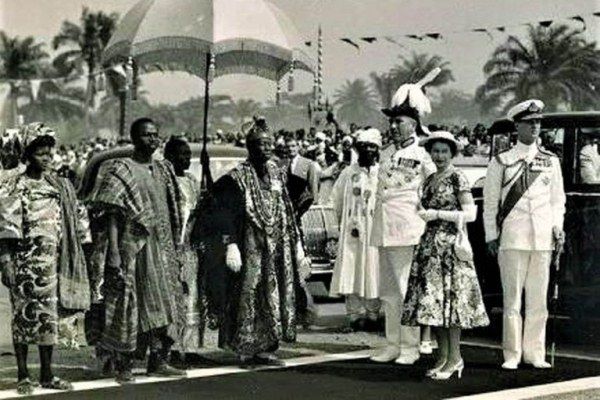
During her reign as head of state and Queen of Nigeria, Queen Elizabeth visited Nigeria twice.
The first time was in 1956, from the 28 th of January to the 16 th of February, 1956. At the airport, she was welcomed by federal dignitaries which included the Minister for Labour and Welfare at the time, Festus Okotie-Eboh and Governor-General Sir James Robertson. She was driven around in a Rolls Royce in the country’s capital, Lagos with lots of fun fare and royal services. She spent time in the Northern part of the country with the Sultan where she visited Kano and Kaduna. She also visited Jos and Enugu. The second time was when she attended the Common wealth Heads of Government meeting which was held between the 3 rd to the 6 th of December, 2003.
The 2003 Commonwealth Heads of Government Meeting was the eighteenth meeting of the Heads of Government of the Commonwealth of Nations. It was held in Abuja, Nigeria and hosted by the then President, Olusegun Obasanjo.
During the meeting, the Zimbabwean issue was dominant. This was the dispute over Zimbabwe’s suspension which led to another dispute over the re-election of Secretary-General Don McKinnon. Before the end of the meeting, Robert Mugabe’s announced that Zimbabwe was withdrawing from the Commonwealth. This best explains the need for the presence of the Queen at the meeting. In a letter addressed towards the Nigerian President at the time, the Queen explained that her visit was a demonstration of the value Britain attached to its relations with Nigeria and recognition of the country’s role on the international stage. Queen Elizabeth opened the Commonwealth Heads of Government Meeting in Abuja on Friday, 5th December. Herself and the Duke of Edinburgh (often referred to as Her Majesty and His Royal Highness respectively) also attended other events during the Meeting.
During the Queen’s first visit in 1956, she went on a tour, known as the Queen’s 1956 Tour of Nigeria and the following incidents took place
Queen Arrives In Lagos (1956)
Queen Elizabeth and Prince Philip received welcome in the Nigerian capital, Lagos at the very start of the Royal tour
Inauguration Of New Federal Courts (1956)
The Queen attended the inauguration of the new federal courts in Nigeria.
The Queen was at the Durbar also known as the Royal Durbar (1956)
At Kaduna, the then capital of Northern Nigeria, Queen attended a Royal Durbar
The Queen visited Kano (1956)
Queen elizabeth and duke philip visited jos – tin mines (1956).
Nigerian tribal canoes held a regatta for the Queen at Port Harcourt on the Ronny River after which she visited a Leper colony
Queen went on a tour in Enugu, Nigeria (1956)
When on the Royal tour, The Queen went on a visit to children’s rally and a tribal dancing at Enugu, Nigeria.
In Lagos, Queen Elizabeth attended a garden party and a formal session of the Federation Parliament.
The life of Queen Elizabeth
Queen Elizabeth became queen following her father’s death in 1952. She was 25 years old at the time and became the queen regent of seven independent Commonwealth countries which were the United Kingdom, Canada, New Zealand, South Africa, Pakistan, and Ceylon (later renamed Sri Lanka). Many of the colonial realms, to include Nigeria gained independence during the course of her reign. As of the year, 2018, Queen Elizabeth II has been ruling England for 66years and is currently the longest-reigning British monarch in history
The role of Queen Elizabeth in colonial Nigeria
British influence in Nigeria began with the prohibition of the slave trade to British subjects in 1807. In 1861, Britain incorporated Lagos and in 1884, the Oil River Protectorate was established. It was at the Berlin’s conference of 1885 that other European powers acknowledged Britain’s dominance over the Niger area.
From 1886 to 1899, much of the Niger area was ruled by the Royal Niger Company, authorized by charter, and governed by George Taubman Goldie. On 1 January 1900, the Royal Niger Company transferred its territories to the British government for the sum of £865,000; the Southern Nigeria Protectorate and Northern Nigeria Protectorate were then passed from the Royal Niger Company to the Crown. The constitutions after the world war were progressive and allowed for increased representation and electoral government by Nigerians. The colonial period in Nigeria was precisely from 1900 to 1960, after which Nigeria gained its independence.
Queen Elizabeth II was Queen of Nigeria forms 1960- 1963: Nigeria was an independent constitutional monarchy . She was also the monarch of the other commonwealth nations such as the United Kingdom .
Nigeria became independent on 1 October 1960 by a British Act of Parliament. Nnamdi Azikiwe was installed as Governor-General of the federation and Tafawa Balewa continued to serve as head of a democratically elected parliamentary. The Queen was head of state in Nigeria, though her constitutional roles were mostly delegated to the Governor-General of Nigeria . The Governor-General represented the British monarch as head of state and was appointed by the Crown on the advice of the Nigerian prime minister in consultation with the premiers of the regions. The Governor-General was also responsible for appointing the prime minister and for choosing a candidate when there was no parliamentary majority. Other than this, the Governor-General’s office was essentially ceremonial.
The retention of the monarchy was not accepted by all and the political parties in Nigeria at the time agreed that the country should be a republic.
Nigeria adopted the President of Nigeria as head of state, on 1 October 1963 and hence, severed its relationship with the British monarchy.
1 thought on “Queen Elizabeth’s Visit to Nigeria: History & Details”
This article is okay but not telling us the full details,the queen also visited inevitably ode and some other few towns but it wasn’t mentions here and I don’t know why, anyway I got some information here too I haven’t gotten where I saw ither
Leave a Comment Cancel reply
You must be logged in to post a comment.
Global site navigation
- Celebrities
- Celebrity biographies
- Messages - Wishes - Quotes
- TV-shows and movies
- Fashion and style
- Capital Market
- Family and Relationships
Local editions
- Legit Nigeria News
- Legit Hausa News
- Legit Spanish News
- Legit French News
King Eyamba V and King Eyo Honesty II: The two monarch ruling the Efik people
King Eyamba V was one of two monarchs based in the coastal town of Calabar , then made up of two sovereign states.
King Eyo Honesty II of Creek Town presided over the affairs of the other sovereign state also dominated by the Efik ethnic group in the mid-19th Century,
Due to their location along the coast, the Efik dominated the slave trade.
"They acted as middlemen between the African traders from the hinterlands and the white merchants on ships mostly from English cities such as Liverpool and Bristol.
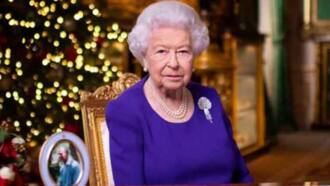
Queen Elizabeth: British government created problems facing Nigeria today, Amechi says
"They negotiated prices for slaves, then collected royalties from both the sellers and buyers," the report stated.
As the slave trade boomed, the "kings became very wealthy" "families became prominent", controlling "the largest trough of slaves coming out of Africa," according to Ex-Governor Duke.
Queen Victoria moves to stop slave trade in Calabar
However, decades after the slave trade was abolished in Britain in 1807, human cargo was still transported to other countries through Calabar.
In a bid to put a final stop to slave trading, Queen Victoria took steps to have the kings of Calabar on her side.
"She wrote a letter asking that they stop trading in people and start trading in spices, palm oil, glassware, and other things," former Governor Duke said.
Queen Victoria's letter to King Eyamba: Where the myth begins
Queen Victoria, in her letter to King Eyamba, allegedly offered inducements that included protection to the Calabar monarch and his people.
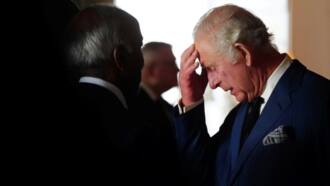
With republicans at the gates, Charles III meets realm envoys
She then signed off the letter as "Queen Victoria, The Queen of England", which a local interpreter incorrectly relayed as "Queen Victoria, The Queen of All White People".
According to the myth, King Eyamba decided that if he was going to accept protection from a woman, that is Queen Victoria, then they had to get married.
He told the Queen so in his written reply, which he also signed off as, "King Eyamba, the King of All Black Men".
"He (King Eyamba) wrote to the Queen and said he wanted to marry her so that the two of them would rule the world," Charles Effiong Offiong-Obo, an Efik chief was quoted as saying.
The myth has it that Queen Victoria simply acknowledged King Eyamba's letter and did not explicitly decline his "marriage" offer.
"She acknowledged the king's letter and said she looked forward to having good trade relations with him," Offiong-Obo said.
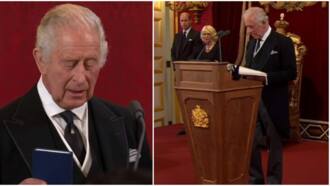
Queen Elizabeth II: Video emerges as Charles III is proclaimed king of Britain in historic ceremony
The Queen's letter in response to King Eyamba was accompanied by some gifts, including a royal cape, a sword , and a Bible.
However, the simple goodwill gesture by the Queen was interpreted by King Eyamba as acceptance of his marriage offer. So, the Efik people began to believe that their king had married the Queen of England.
Sometime in the 20th Century, the Efik people reported agreed to have only one monarch, known as an Obong (of Calabar. Thus, the thrones once occupied by Kings Eyamba and Honesty were merged.
In-law is in town: Prince Michael of Kent's 2017 visit to Calabar
In 2017, Prince Michael of Kent paid a brief private visit to Calabar. However, the reigning Obong, Edidem Ekpo Okon Abasi Otu V, got to know that he was in town.
Prince Michael, being a member of the British royal family and first cousin of Queen Elizabeth II, was considered an in-law by the Obong, based on thy myth that King Eyamba "married" Queen Victoria.
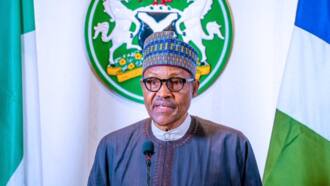
FG orders Nigerian flags to fly at half-mast to honour Queen Elizabeth II
The Calabar monarch feted the prince and made him a chief with the title Ada Idagha Ke Efik Eburutu, meaning "A person of honour and high standing in the Efik Eburutu Kingdom".
A grand ceremony to confer the title on Prince Michael took place at the Obong's palace.
"During Prince Michael's visit, at every opportunity, they reminded him that he was their in-law. Even at the ceremony, they told that story again," said Barbara Etim James, an obong-awan, or queen, among the Efik who planned the chieftaincy ceremony.
"Prince Michael was delighted to hear the historical ties between the Efik and British royalty and was honoured to be deepening those ties with his Efik chieftaincy," she added.
The Obong of Calabar has two thrones: One for obong, the other for Queen Victoria
In line with the tradition that began following King Eyamba's "marriage" to Queen Victoria, the coronation of the Obong of Calabar still takes place in two phases, according to the BBC report.
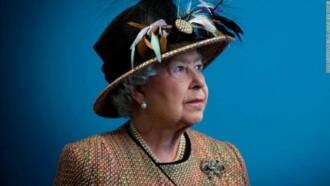
Why FG should name Aso Rock after Queen Elizabeth, Ohanaeze Ndigbo gives reasons
After the traditional rites are concluded in the community, the coronation ceremony continues in a Presbyterian Church (formerly the Church of Scotland), where the obong wears a crown and cape custom-made for the occasion in England.
Legit.ng gathers that two thrones are set side by side and he sits on one, while the second is left empty for the absent Queen of England (or a Bible placed on it).
The king's wife known wife sits behind him.
Queen Elizabeth calls off meeting
Earlier, Legit.ng reported that Queen Elizabeth II postponed a meeting of her Privy Council advisory group after doctors advised her to rest, Buckingham Palace said Wednesday, the day after she appointed Liz Truss as Britain's new prime minister.
"After a full day yesterday, Her Majesty has this afternoon accepted doctors' advice to rest," the palace said in a statement released before the monarch's death.
"This means that the Privy Council meeting that had been due to take place this evening will be rearranged."
Source: Legit.ng
- Advertise with us
- Thursday, April 25, 2024
Most Widely Read Newspaper
PunchNG Menu:
- Special Features
- Sex & Relationship
ID) . '?utm_source=news-flash&utm_medium=web"> Download Punch Lite App
Chair Queen Elizabeth gave Lagos cathedral in 1956 still strong, hasn’t been repaired once – Provost

The Cathedral Church of Christ, Marina, Lagos and Provost of the church, Very Rev Adebola Ojofeitimi
Kindly share this story:
- Man who threatened to kill Queen Elizabeth sentenced to prison
- UK marks first anniversary of Queen Elizabeth II's death
- Pictorial: King Charles III takes oath of office
- Lagos cathedral
- Queen Elizabeth
All rights reserved. This material, and other digital content on this website, may not be reproduced, published, broadcast, rewritten or redistributed in whole or in part without prior express written permission from PUNCH.
Contact: [email protected]
Stay informed and ahead of the curve! Follow The Punch Newspaper on WhatsApp for real-time updates, breaking news, and exclusive content. Don't miss a headline – join now!

Latest News
Lagos workers now earn minimum of n70,000 since january - sanwo-olu, ondo pdp primary: delegates accreditation begins, xavi, barca tied in marriage of convenience, ‘dey play,’ nigerians mock prophet who claims world ends today, i am still in uk, lady in viral video debunks report of relocating to nigeria.

How flight engineer saved us from disaster — Joe Abah
Lorem ipsum dolor sit amet, conse adipiscing elit.

- Thursday, April 25, 2024

© 2023 - Businessday NG. All Rights Reserved.

- Switch skin
Queen Elizabeth’s First Visit to Nigeria in 1956 (with Video)
The Queen of England, Queen Elizabeth II, visited Nigeria for the first time on the 28th of January, 1956, four years to Nigeria’s independence and stayed for 20 days.
She was received with a military parade at the Ikeja Airport in Lagos and welcomed by dignitaries such as the then Governor-General, Sir James Robertson, his wife, the Minister of Labour ( Festus Okotie-Eboh ) and the Oba of Benin, Oba Akenzua II.

Nigerians, eager to see the Queen, stormed the streets of Lagos with banners and flags. Queen Elizabeth II and the Duke of Edinburgh were driven past the cheering crowds in an open car to the Municipal Boundary.

Queen Elizabeth II also met with the Oba of Lagos, Oba Adeniji-Adele II. Little Folashade Lawson, daughter of the Chairman of Lagos Town Council, presented Queen Elizabeth II a bouquet on her knees.
Before the Queen left on the 16th of February, 1956, she visited other parts of Nigeria such as Port Harcourt and Kaduna where she graced the Dubar festival.
Thanks for reading, OldNaija.com
Questions? Advert? Click here to mail us or click here to call us.
You Might Also Like

Northern People’s Congress (NPC)

Watch the Video of Nigeria’s Independence Day Celebration in 1978

How and Why Flora Shaw, Lord Lugard’s Wife, Coined the name Nigeria in 1897


The Clifford Constitution of 1922 – Features, Merits & Demerits

Adubi War (Ogun Adubi) of 1918

Watch Three Roads To Tomorrow – A Nigerian Film Shot In 1958
This site wows me. i just can’t leave it. so interesting. Can i add you up on fb please. would love to write for you. even if it’s free. just want to contribute.
Yes you can. Your contributions will be much appreciated. Thank you, Mr. Oty Emmanuel.
It is great to be here. This will rekindle my unrivaled love for history. i hope to write for you also.
It’s also great to have you here, Miss/Mrs Quincy Onuwaje. I’m glad to know you’re a history lover. I’ll be looking forward to working with you. Kindly contact me with the number on the sidebar. Cheers!
Leave a Reply. OldNaija loves your comment. Cancel reply

When Queen Elizabeth II Visited Nigeria

By Toyosi Onabanjo
Queen Elizabeth II’s death on 8 September has occasioned many tributes but also many Twitter jokes, some of them about the late Queen’s cherished Pembroke Welsh corgis. Being a former Queen of Nigeria, it is expected that Nigerians have an opinion about the monarch who passed away aged 96 at the Balmoral Castle in Scotland. Thus far, the reactions have been mixed—many have hailed the Queen, the gospel singer Tope Alabi going as far as making a montage in veneration; some others have tweeted less than salubrious remarks. But at least all can agree that the Queen is one of the most important people in world history.
Born Elizabeth Alexandra Mary on 21 April 1926, she ascended the British throne in 1952, following the death of her father and former king, George VII. At only twenty-five years old, she became the queen of seven independent Commonwealth countries: The United Kingdom, Australia, New Zealand, South Africa, Pakistan, and Ceylon (now Sri Lanka). She was Nigeria’s constitutional monarch from 1960 until 1 October 1963 when Nigeria became a republic.
At the time of succeeding her father, the British Empire was on the cusp of its demise and many former British colonies were clamoring for independence, with Ghana attaining it in 1957 and Somalia and Nigeria both attaining theirs in 1960.
Elizabeth was crowned in 1953, a year after her father’s passing. As queen, one of her ceremonial duties included visiting the British colonies, to which Nigeria belonged. She visited Nigeria twice—in 1956 when Nigeria was a British colony and in 2003 when Nigeria was already a sovereign nation.
First Visit
Queen Elizabeth’s visit to Nigeria in 1956 happened three years after ascending the British throne. She landed in Nigeria’s former capital, Lagos, along with her entourage, among whom was her late husband, Philip Mountbatten, the Duke of Edinburgh. She was received by thousands at the airport. In that number was the then Governor-General of Nigeria, James Robertson; Festus Okotie-Eboh; and the then-Oba of Lagos, Adenji-Adele II . A twenty-eight-year-old Elizabeth wore a pink floral dress, a brimmed hat, and a pair of white opera gloves to match a white handbag. She was a picture of youth and royalty.
She spent twenty days in Nigeria, from 28 January to 16 February. In her husband’s company, she toured the country, visiting Kano, Kaduna, Enugu, among others.
She worshipped at the Cathedral Church of Christ in Marina, Lagos, an Anglican church founded by Reverend Samuel Ajayi Crowther and which during the Queen’s visit was under the provost Reverend A.W. Howells. During her visit, the Queen donated a chair to the cathedral.
While in Nigeria, the Queen commissioned the Nigerian painter and sculptor Ben Enwonwu to make a bronze sculpture of herself. The next year, she posed in London as Enwonwu banged metal against his imagination in order to bring an outsized version of the Queen to life. The sculpture was completed in 1957, and in November of the same year was presented at the Royal Society of British Artists exhibition in London.
Second Visit
The second time Queen Elizabeth visited Nigeria, she was 76 years old. She retained the brimmed hat, but this time it nested wreaths of grey hair. The flower of youth had withered, but the royal grace endured.
This time the Queen visited Abuja and was hosted by then-President Olusegun Obasanjo. She was in the country to attend the Commonwealth Heads of Government meeting—the 18th of its kind—that had representatives from 51 Commonwealth countries in attendance. 3 Commonwealth nations were not in attendance—the suspended Zimbabwe and Pakistan who were not invited, and Antigua and Barbuda who were not suspended but sent no representative.
The meeting garnered great media attention at the time. Discussed in the meeting was Zimbabwe’s controversial suspension from the Commonwealth of Nations. There was also a dispute over the re-election of the New Zealander Don McKinnon as Secretary General.
The Queen was in Nigeria from December 3rd to December 6th.
In spite of the controversies that have tailed her public life and some negative remarks that have tailed her demise, the Queen leaves behind a rich legacy. Having reigned for 70 years and 214 days, Queen Elizabeth II was the longest-serving British monarch and the longest recorded of any female head of state. She was the second longest-reigning monarch in world history, only behind France’s Louis XXIV. Her death itself is symbolic. Having lived nearly a century, in which time she lived through major global political and cultural changes, her demise in many ways epitomizes the end of an era. Or two eras. Or three.
Queen Elizabeth II is succeeded by her eldest son, Charles III.
Toyosi Onabanjo is a freelance technical and entertainment writer who lives in Lagos.
Related Posts
- Celebrities
- Beauty & Health
- Relationships & Weddings
- Food, Travel, Arts & Culture
- International
- Pulse Picks
- Celebrity Picks
- Pulse Influencer Awards
How many times did Queen Elizabeth visit Nigeria?
The Queen died yesterday Thursday, September 8th 2022 at the age of 96 and it is a good time to begin a throwback on the times she visited Nigeria.
The Queen (Queen Elizabeth II) was the monarchical authority who had the constitutional position as the Head of State of Nigeria from 1953-1963. She was officially called Queen of Nigeria
Recommended articles
Who is the queen.
The Queen is the ruler of the United Kingdom and the other commonwealth nations. During the British rule of Nigeria, Queen Elizabeth served as a monarch until the end of the Republic in 1963. She performed ceremonial duties in her capacity as the head of state of colonized Nigeria.
She visited Nigeria twice.
She came to Nigeria for the first time in 1956 as part of her royal tour to Commonwealth countries, from January 28 to February 16.
Her arrival was full of pomp and pageantry. Many dignitaries greeted her at the airport, including Sir James Robertson, the governor-general, and Festus Okotie-Eboh, the then-minister of Labour and Welfare and many heads of government and traditional leaders.
The former capital was Lagos state and that was where she landed. She was driven around in a Rolls Royce. She went on a royal tour of Lagos and many places other places. She also travelled to Northern Nigeria where she visited the Sultan of Sokoto. The Queen also went to Kano, Kaduna, Enugu and Jos.
The second time she visited Nigeria was during the Commonwealth Heads of Government Meeting, which took place from December third to sixth 2003.
The Commonwealth Heads of Government Meeting in 2003 was the 18th time the Commonwealth heads were met.
Olusegun Obasanjo , Nigeria's then-president, hosted the event in Abuja. She came with her husband the Duke of Edinburgh.
The conflict during the Commonwealth meeting was the crisis in Zimbabwe over Secretary-General Don McKinnon's re-election. Robert Mugabe declared that Zimbabwe was leaving the Commonwealth just before the gathering ended.
Even though many countries were declaring independence at the time she ascended the throne (1953), the Queen always expressed love for the Commonwealth countries.
JOIN OUR PULSE COMMUNITY!
Welcome to the Pulse Community! We will now be sending you a daily newsletter on news, entertainment and more. Also join us across all of our other channels - we love to be connected!
Eyewitness? Submit your stories now via social or:
Email: [email protected]
Why commercial aeroplanes don't have parachutes for passengers
Items & services you will pay for twice the normal price during rainy season, experience moët hennessy with some of the best drink vendors in nigeria, what panic attacks are and how to deal with them, here are 4 reasons men and women communicate differently — these can cause problems, more reasons muslim women wear hijab beyond religious observance, 10 most peaceful countries to live in, are you self-confident or are you a narcissist here are 5 ways to tell, what are the differences between bipolar i and bipolar ii, here’s how broccoli can help you reach your weight loss goals, top 5 least visited countries in the world, can coffee help your sex life the truth about caffeine and erectile dysfunction, pulse sports.
Welcome to the Pulse Community! We will now be sending you a daily newsletter on news, entertainment and more. Also join us across all of our other channels - we love to be connected! Welcome to the Pulse Community! We will now be sending you a daily newsletter on news, entertainment and more. Also join us across all of our other channels - we love to be connected!
Okin biscuits and 9 other snacks millennials loved as children
It's illegal to publicly celebrate your birthday in this country
See the most preserved dead body in the world that looks almost alive
5 retinol-rich foods for healthy and ageless skin.
- AI Generator
650 The Queen Visits Nigeria Stock Photos & High-Res Pictures
Browse 650 the queen visits nigeria photos and images available, or start a new search to explore more photos and images..
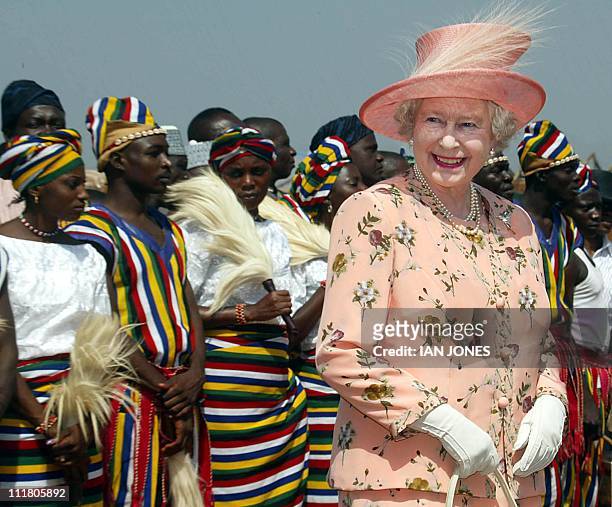

- Sign Up (2)
- f2fafrica.com
Keagborekuzi I, the Nigerian man who became the world’s youngest monarch at age two

Many children at age two would be playing games or having fun with other kids but not for Benjamin Ikenchukwu Keagborekuzi I. At that tender age, he had been crowned king or Dein of the Agbor Kingdom, a Nigerian traditional state in Delta State, Nigeria. Born on June 29, 1977, Keagborekuzi I also set a record as the youngest monarch in the entire world at his installation in 1979.
His installation at just 28 months old, which was recorded in the 1981 edition of the Guinness Book of World Records, followed the untimely death of his father and then reigning Agbor monarch, James Obika Ikechukwu. Ascending the throne at that age followed the tradition of hereditary succession. That tradition began during the third dynasty of Agbor royalty in 1270 AD under the reign of Dein, after whom the title of the current monarchy is known.
Agbor, an ancient kingdom, has never been defeated even by the neighboring Benin Kingdom, according to some records. It is basically made up of three distinct dynasties: the Ogiso dynasty, the Ogene dynasty, and the Dein dynasty, which is the current one. Dein, who began the third dynasty of the Agbor royalty, reigned for 37 years (from 1270 to 1307 AD), before he passed away. His son, Dein Owuwu, was made king. Owuwu reigned for 26 years (from 1307 to 1333), according to one account. It was in October 1979 that Keagorekuzi I was made king. This was after his father, who had reigned for 11 years, died.
Keagorekuzi I became the 18th king of the kingdom at just two and a half years old. But due to security concerns largely in connection with the sustainability of the stool, Keagorekuzi I and some members of the royal family relocated abroad. Keagorekuzi I remained there for about 25 years and returned recently to his kingdom where he has since rallied his subjects around the crown while ensuring peace and instituting reforms to better the lives of his people.
Being a constitutional democracy, Nigeria elects its representatives, however, the hundreds of ethnic communities scattered across the country still acknowledge their own traditional rulers. It was tough for the people of Agbor while their king was away.
“Really, my stay abroad affected the development of the kingdom 100 per cent. We are talking about 25 years of not having their king around,” Keagorekuzi I told The Punch recently. “Certainly, my long stay abroad caused huge problems and we are still dealing with them because the majority of Agbor people grew up without knowing their king, so they don’t know what it takes to serve a king anymore. Now we are learning almost from the scratch.”
For Keagorekuzi I, the most interesting part of being a monarch is the opportunity to make a change though he indicated that it’s been “extremely frustrating”. He said it is worrying that Nigeria is “going backwards” instead of making use of its abundant mineral resources. His other challenge as the Dein (king) of Agbor is the opposition he gets from the elite.
“Let me tell you the truth, if the elite in Agbor cooperated with me, I would have made Agbor like Dubai,” he said in his interview with The Punch. “If they [elite] would work with me in Agbor; in five years, I would make Agbor so beautiful and functional that the government of the day would be forced to know it is so possible,” he said in 2019.
Despite the challenges, the 44-year-old remains one of Nigeria’s most exposed kings. Apart from being a guest of honor/ guest speaker at Belgium King’s Day celebrations and guest of honor at Spanish Day celebrations, he was a guest of the German Embassy during the visit of the German Chancellor to Nigeria. Keagorekuzi I was also one of the monarchs invited by the Federal Government to receive the Queen of England during her visit to Nigeria.
He has also been invited to many African and European nations and in 2006, then-Nigerian President Olusegun Obasanjo named him the Chancellor of a University, making him the youngest Chancellor of any university – public or private — in all of Africa at age 29.
Conversations

Help us create more content like this
Subscribe to premium
Already a member? Sign in.

Connect with us
Join our Mailing List to Receive Updates
Saturday 10 September 2022
Queen elizabeth’s visit to nigeria: history & details.
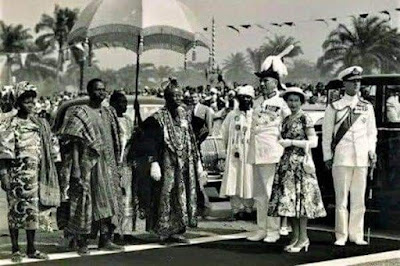
An important part of the history of Nigeria is her colonial story. Under colonialism and under the administration of Britain, the Queen (Queen Elizabeth) was the highest monarchical authority who was in control of government affairs. She carried out ceremonial functions in her position as head of state in the colonised Nigeria. She was also the monarch of the other common wealth realms, including the United Kingdom.
Even when Nigeria gained her independence in 1960, the Queen still held a high and important status in Nigeria. Queen Elizabeth was Queen of Nigeria from 1960-1963, the time between the nation’s independence and when she became a republic. You can see now the reasons her visits to Nigeria were always with such great fuss.
During her reign as head of state and Queen of Nigeria, Queen Elizabeth visited Nigeria twice.
The first time was in 1956, from the 28th of January to the 16th of February, 1956. At the airport, she was welcomed by federal dignitaries which included the Minister for Labour and Welfare at the time, Festus Okotie-Eboh and Governor-General Sir James Robertson. She was driven around in a Rolls Royce in the country’s capital, Lagos with lots of fun fare and royal services. She spent time in the Northern part of the country with the Sultan where she visited Kano and Kaduna. She also visited Jos and Enugu. The second time was when she attended the Common wealth Heads of Government meeting which was held between the 3rd to the 6th of December, 2003.
The 2003 Commonwealth Heads of Government Meeting was the eighteenth meeting of the Heads of Government of the Commonwealth of Nations. It was held in Abuja, Nigeria and hosted by the then President, Olusegun Obasanjo.
During the meeting, the Zimbabwean issue was dominant. This was the dispute over Zimbabwe’s suspension which led to another dispute over the re-election of Secretary-General Don McKinnon. Before the end of the meeting, Robert Mugabe’s announced that Zimbabwe was withdrawing from the Commonwealth.
This best explains the need for the presence of the Queen at the meeting. In a letter addressed towards the Nigerian President at the time, the Queen explained that her visit was a demonstration of the value Britain attached to its relations with Nigeria and recognition of the country’s role on the international stage. Queen Elizabeth opened the Commonwealth Heads of Government Meeting in Abuja on Friday, 5th December. Herself and the Duke of Edinburgh (often referred to as Her Majesty and His Royal Highness respectively) also attended other events during the Meeting.
During the Queen’s first visit in 1956, she went on a tour, known as the Queen’s 1956 Tour of Nigeria and the following incidents took place:
- Queen Arrives In Lagos (1956)
Queen Elizabeth and Prince Philip received welcome in the Nigerian capital, Lagos at the very start of the Royal tour.
- Inauguration Of New Federal Courts (1956)
The Queen attended the inauguration of the new federal courts in Nigeria.
- The Queen was at the Durbar also known as the Royal Durbar (1956)
At Kaduna, the then capital of Northern Nigeria, Queen attended a Royal Durbar
- Queen Elizabeth And Duke Philip Visited Jos – Tin Mines (1956)
Nigerian tribal canoes held a regatta for the Queen at Port Harcourt on the Ronny River after which she visited a Leper colony.
- Queen went on a tour in Enugu, Nigeria (1956)
When on the Royal tour, The Queen went on a visit to children’s rally and a tribal dancing at Enugu, Nigeria.
In Lagos, Queen Elizabeth attended a garden party and a formal session of the Federation Parliament.
- The life of Queen Elizabeth
Queen Elizabeth became queen following her father’s death in 1952. She was 25 years old at the time and became the queen regent of seven independent Commonwealth countries which were the United Kingdom, Canada, New Zealand, South Africa, Pakistan, and Ceylon (later renamed Sri Lanka). Many of the colonial realms, to include Nigeria gained independence during the course of her reign. As of the year, 2018, Queen Elizabeth II has been ruling England for 66years and is currently the longest-reigning British monarch in history.
- The role of Queen Elizabeth in colonial Nigeria
British influence in Nigeria began with the prohibition of the slave trade to British subjects in 1807. In 1861, Britain incorporated Lagos and in 1884, the Oil River Protectorate was established. It was at the Berlin’s conference of 1885 that other European powers acknowledged Britain’s dominance over the Niger area.
From 1886 to 1899, much of the Niger area was ruled by the Royal Niger Company, authorized by charter, and governed by George Taubman Goldie. On 1 January 1900, the Royal Niger Company transferred its territories to the British government for the sum of £865,000; the Southern Nigeria Protectorate and Northern Nigeria Protectorate were then passed from the Royal Niger Company to the Crown. The constitutions after the world war were progressive and allowed for increased representation and electoral government by Nigerians. The colonial period in Nigeria was precisely from 1900 to 1960, after which Nigeria gained its independence.
Queen Elizabeth II was Queen of Nigeria forms 1960- 1963: Nigeria was an independent constitutional monarchy. She was also the monarch of the other commonwealth nations such as the United Kingdom.
Nigeria became independent on 1 October 1960 by a British Act of Parliament. Nnamdi Azikiwe was installed as Governor-General of the federation and Tafawa Balewa continued to serve as head of a democratically elected parliamentary. The Queen was head of state in Nigeria, though her constitutional roles were mostly delegated to the Governor-General of Nigeria. The Governor-General represented the British monarch as head of state and was appointed by the Crown on the advice of the Nigerian prime minister in consultation with the premiers of the regions. The Governor-General was also responsible for appointing the prime minister and for choosing a candidate when there was no parliamentary majority. Other than this, the Governor-General’s office was essentially ceremonial.
The retention of the monarchy was not accepted by all and the political parties in Nigeria at the time agreed that the country should be a republic.
Nigeria adopted the President of Nigeria as head of state, on 1 October 1963 and hence, severed its relationship with the British monarchy.
Gossip House
Great work. Keep it up!!!!

Secret Detour Queen of England made During Nigerian State Visit Revealed
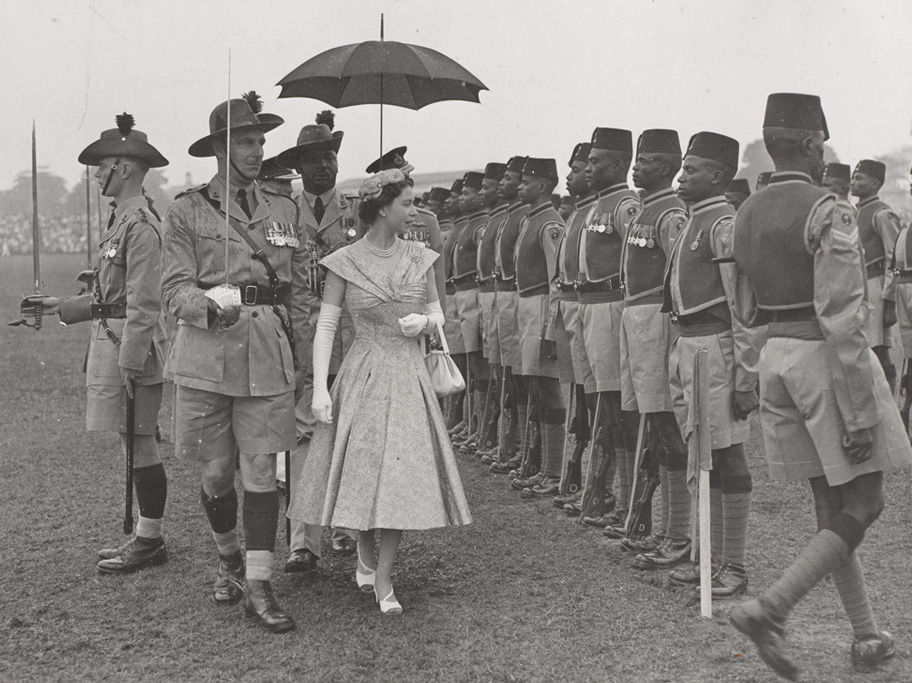
A state visit from the Queen of England is a rare thing indeed, but it did happen when the current Queen of England, Queen Elizabeth paid a special visit to Nigeria for the first time on the 28th of January, 1956, four years to Nigeria’s independence.
She was greeted with a lot of fanfare and was greeted at the Ikeja Airport, Lagos, with a military parade and by dignitaries such as the then Governor-General, Sir James Robertson, his wife, the Minister of Labour, Festus Okotie-Eboh and the Oba of Benin, Oba Akenzua II. She stayed for 20 days and was supposed to visit only Ibadan, Enugu and Kaduna as the regional capitals.
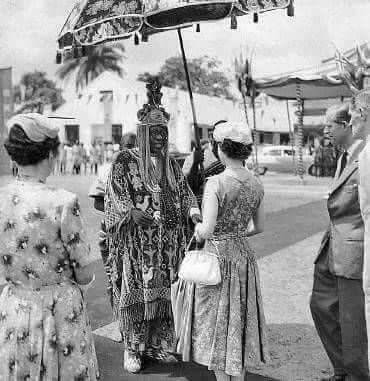
What many never knew was that she made an unscheduled stop in Ijebu Ode.
This visit was for a special man. It was none other than Chief Timothy Adeola Odutola, the Ogbeni Oja, her father’s friend who usually wined and dined with the royals at Buckingham Palace.
Chief Odutola was one of the pioneers of Nigerian business. One of the richest men in Nigeria, he was also the first president of the Manufacturers Association of Nigeria.
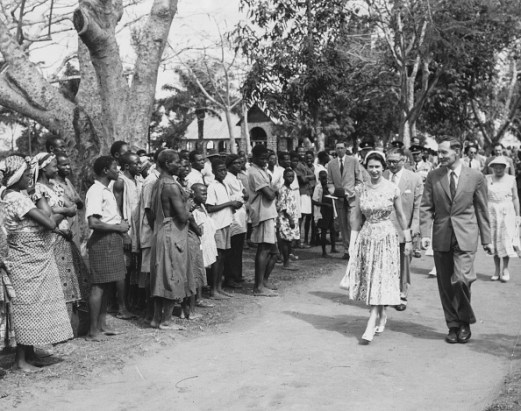
He was also responsible for establishing various factories in the country, spanning, the transport and food industry, He was also a member and later president of the Nigerian Stock Exchange and the Manufacturers Association of Nigeria in the early 70s.
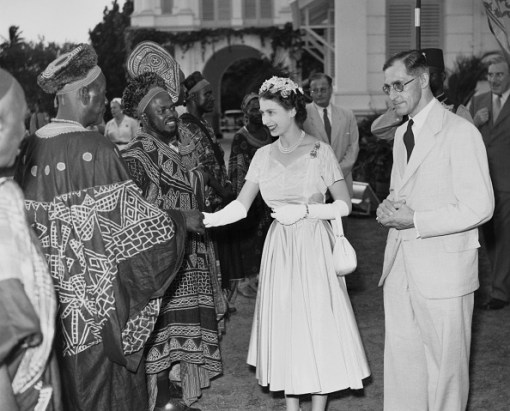
The Queen passed a night at Ijebu-Ode and Chief Odutola was forever remembered as a legend. He was dubbed “Eni ti Oba Obirin wa ki lati ilu Oyinbo” (The man the Queen came to Visit from the land of the Whites)
Share with friends:

Leave a Reply
- Default Comments
- Facebook Comments
Leave a Reply Cancel reply
Your email address will not be published. Required fields are marked *
Save my name, email, and website in this browser for the next time I comment.
This site uses Akismet to reduce spam. Learn how your comment data is processed .
Recent Posts
- “Viral video taken in Ethiopia” – FCT police debunk claim of armed thugs waylaying Abuja drivers in traffic
- LAAF Holds Men’s Mental Health Workshop at Rotary Club of Ikeja
- Soulja Boy Makes Playful Bid for TikTok After US Ban Threat
- 2Baba’s Daughter Defends Parents’ Portrayal in “Young, Famous and African”
- Lagos govt seals off Carrillion Construction’s office over discharge of sewage into public drainage
- Tinubu approves takeoff of Consumer Credit Scheme
- EFCC hands over 14 properties forfeited by ex-Enugu governor, Chimaroke Nnamani, to state
- Deep dive with Michelle Alozie: How the legend joined the Super Falcons
- Yul Edochie Announces Desire for Large Family, Sparks Conversation
- Rotimi Sparks Debate on Pioneering Afrobeats in the US
Email address:
Sign in to your account
Username or Email Address
Remember Me
Our last Shop TODAY box sold out in 90 minutes! How to get one now
- TODAY Plaza
- Share this —

- Watch Full Episodes
- Read With Jenna
- Inspirational
- Relationships
- TODAY Table
- Newsletters
- Start TODAY
- Shop TODAY Awards
- Citi Concert Series
- Listen All Day
Follow today
More Brands
- On The Show
Queen Elizabeth statue with corgis unveiled on what would have been her 98th birthday
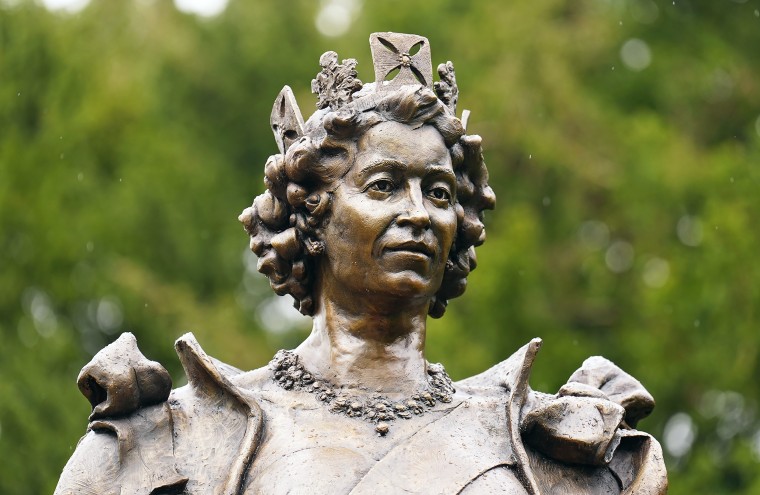
A small English town has immortalized a group of iconic British figures: Queen Elizabeth II and her corgis.
The memorial statue to the late monarch was unveiled on April 21 in Oakham, England — a bronze monument of the queen in royal regalia with her cherished dogs at her feet.
An official celebration marked the unveiling of the statue created by sculptor Hywel Pratley, which stands near the town's library, according to Rutland County Council 's post on Instagram. The RCC wrote that the statue is the "first permanent memorial" to the late queen.
The ceremony was held on what would've been Queen Elizabeth's 98th birthday. She died at 96 in 2022 after a 70-year run as Britain's longest-reigning monarch.
The statue was commissioned by Dr. Sarah Furness, Lord-Lieutenant of Rutland, who appeared at the event along with other local dignitaries, high school bands and bagpipers, according to the RCC. The design for the corgi dogs was created by local children, the RCC stated.
“What most of us remember about Queen Elizabeth is her warmth,” Furness said in a speech, according to The New York Times . “By showing Queen Elizabeth’s love of dogs, we show her humanity."
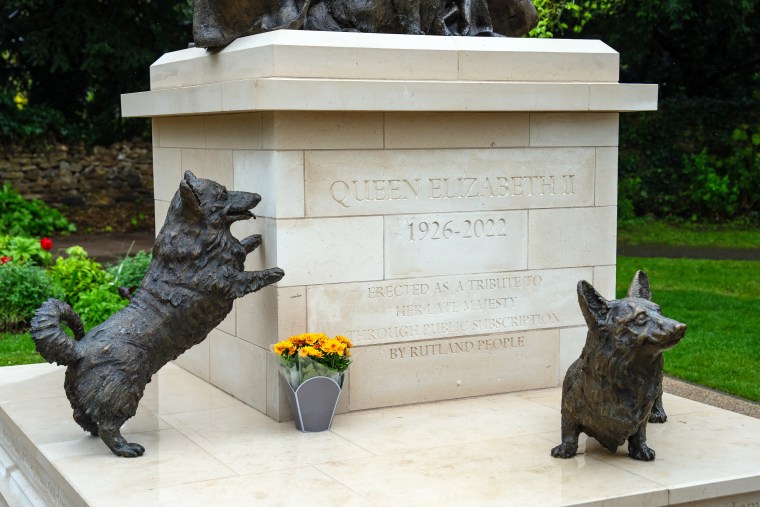
Funding for the statue was raised from donations by the public and local businesses, according to the BBC . The ceremony brought fans of Queen Elizabeth from around the country.
“I miss (the Queen), and I wanted to come and see what the statue was like," spectator Jodie Paterson told the BBC.
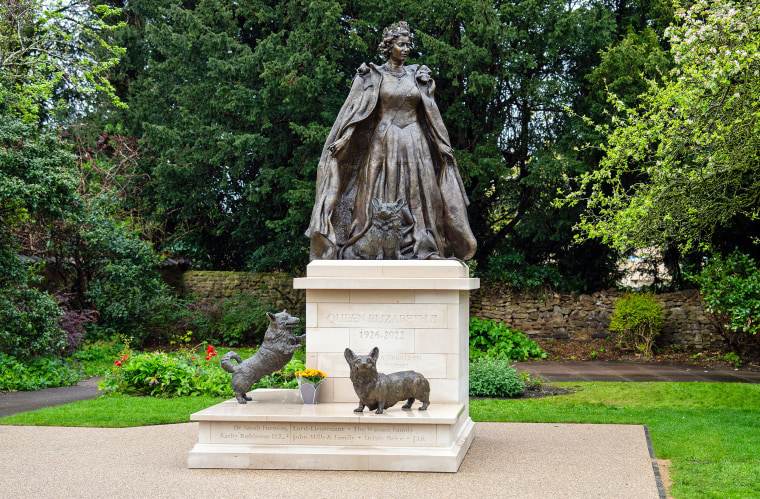
The statue is the latest monument to the queen in the 18 months since her death. Another statue of the late monarch was unveiled at London's Royal Albert Hall in December 2023.
Scott Stump is a trending reporter and the writer of the daily newsletter This is TODAY (which you should subscribe to here! ) that brings the day's news, health tips, parenting stories, recipes and a daily delight right to your inbox. He has been a regular contributor for TODAY.com since 2011, producing features and news for pop culture, parents, politics, health, style, food and pretty much everything else.
Runaway military horses race through London, one seemingly covered in blood
LONDON — There was mayhem at rush hour in the British capital Wednesday when five elite military horses — one of them apparently covered in blood — broke loose and galloped riderless through miles of downtown London.
First responders raced to incidents 5 miles across the capital after the steeds from the Household Cavalry, the top regiment of the British Army, became spooked by construction work, the army said.
Four military riders were thrown from their mounts, which then charged past iconic landmarks and collided with vehicles, including a black London taxi and a double-decker tour bus, damaging its windshield.
“A number of personnel and horses have been injured and are receiving the appropriate medical attention,” the army said in a statement after the horses were finally contained.
The surreal image of saddled horses bolting through one of the largest cities in the world prompted Brits on social media to joke — perhaps nervously — that it may be a portent for some terrible looming event. The hashtag #Apocalypse briefly trended on X in the famously sardonic United Kingdom.
For hours it was unclear what led to the bizarre spectacle and whether it had been brought to an end, until details were slowly drip-fed by the army, police and ambulance services.
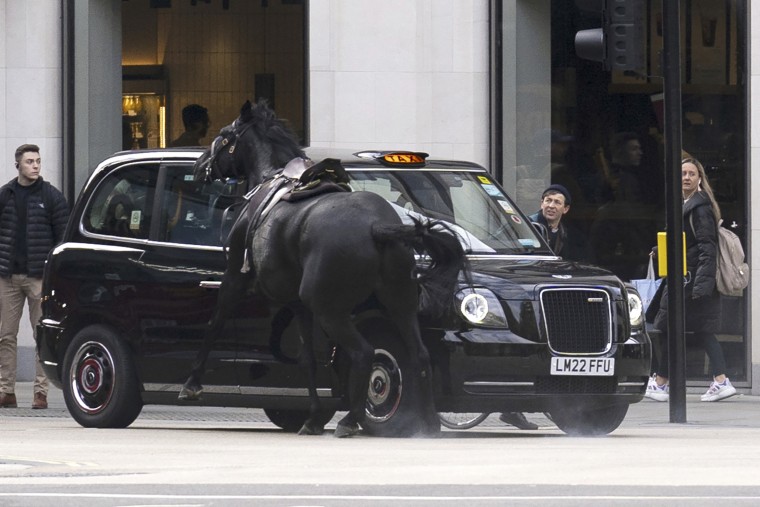
At around 8 a.m. (3 a.m. ET), a group of six riders and seven horses from the Life Guards, part of the Household Cavalry, were out on what's known as a "watering order." That is a training exercise designed to familiarize the animals with the varied and unpredictable sights and sounds of the bustling metropolis.
It's a necessary step for the animals, which as part of an elite mounted unit participate in the king’s birthday and other ceremonial parades enjoyed by London's thronging tourists.
Their riders' chest armor, swords and distinctive helmets, adorned with plumes of horses' hair, will be familiar to anyone who watches Britain’s opulent royal events in person or on TV.
However, the training exercise ran into trouble as the unit passed Wilton Crescent, a lavish, sweeping terrace built in the 1800s in the affluent Belgravia area of London. Nearby construction workers were using a conveyor belt to shift concrete, some of which fell off and hit the floor, according to the army.
That caused the horses to spook, with five of the seven animals bolting, the army said. As they rampaged the streets, the four horses that were mounted threw off their riders, with the other unmanned horse joining the posse, the army said.
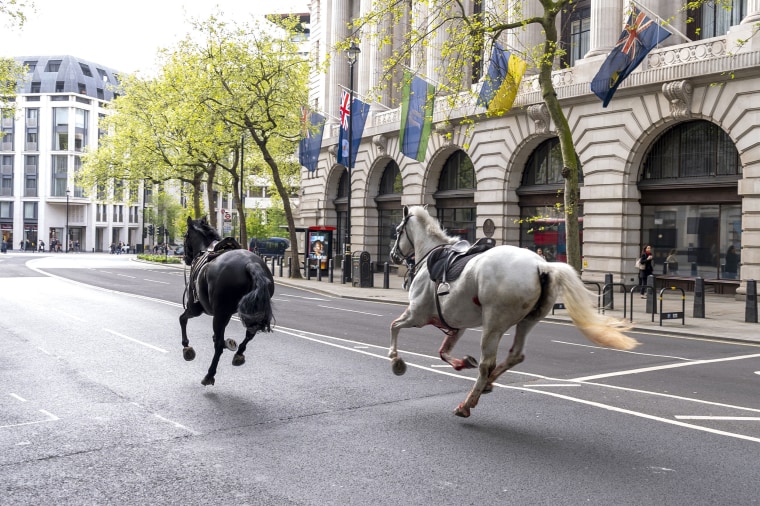
First responders rushed to the scene and treated two people for injuries, the London Ambulance Service said. More paramedics were called to nearby Buckingham Palace Road, where another of the riders was thrown from a horse, it said. Crews there treated someone in the street behind a blue tarpaulin.
The horses galloped for miles. And another ambulance crew treated a horse-related injury at a busy junction not far from St. Paul's Cathedral, it said. In total, three riders were injured and taken to hospitals with non-life-threatening injuries, according to the army.
It wasn't clear exactly when the horses were brought under control, but by 10:30 a.m. the army said the animals had been contained and returned to camp.
Officials said some of the horses had been injured, although it was not clear what caused the large patch of blood that appeared to be splashed across the chest and front legs of one of them. The BBC sent a reporter to Limehouse, an area in the east of the city where at least some of the animals were retrieved, where they photographed a large patch of blood and horse manure on the sidewalk.
A cab driver, identified only as Robbie, told the U.K. public broadcaster he had heard “galloping and looked behind and there were about three or four horses.”
“I looked in the rear mirror and saw them coming right up behind me,” he added, saying his main concern were the two passengers in the back of his cab. “Luckily they swerved towards the middle of the road and carried on, but they were going at some speed.”
He described one of the horses as being “covered in blood” and said that “it looked like it was injured quite badly.”
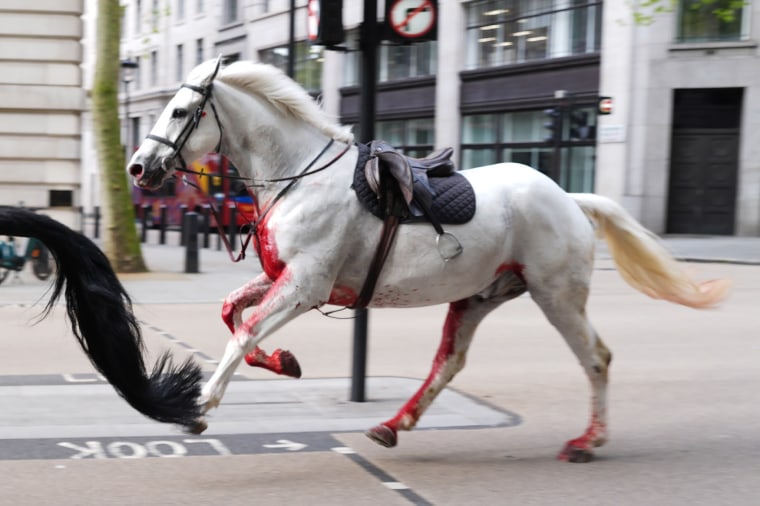
The City of London Police said in a statement that it was "pleased to confirm that all of the horses have been accounted for. We are continuing to liaise with the Army."
While the pandemonium was underway, the clock in the Elizabeth Tower — more commonly known as Big Ben, the city's most recognizable landmark and usually an icon of stability — stopped without explanation at 9 a.m.
Users on social media reflected that the dramatic scenes resembled a portent for some apocalyptic event, though it was unclear whether the horses' being caught would ward off such a scenario.
Alexander Smith is a senior reporter for NBC News Digital based in London.

IMAGES
VIDEO
COMMENTS
Queen Elizabeth was Queen of Nigeria from 1960-1963, the time between the nation's independence and when she became a republic. You can see now the reasons her visits to Nigeria were always with such great fuss. During her reign as head of state and Queen of Nigeria, Queen Elizabeth visited Nigeria twice. The first time was in 1956, from the ...
There is approximately a time frame of 53 years between both visits to Nigeria by the monarch. Queen Elizabeth's 1st visit: 28 January - 16 February 1956. About three years after she was coronated as the monarch of England (1953), Queen Elizabeth toured parts of the British empire and the commonwealth, a feat her predecessors never achieved.
This was the first of two visits Queen Elizabeth made to Nigeria, in 1956, when it was still a British colony. ... on her first official state visit to Africa as Queen in 1954. All pictures ...
Queen Elizabeth II inspects men of the newly-renamed Queen's Own Nigeria Regiment, Royal West African Frontier Force, at Kaduna Airport, Nigeria, during her Commonwealth Tour, on February 2, 1956.
As a result of the myth, a throne is reserved for the Queen of England in the West African state, up till today. The myth, according to Nigerian journalist and novelist Adaobi Tricia Nwaubani in a report by BBC, is that one of the Efik's 19th Century kings was married to Queen Victoria of England, one of the predecessors of Queen Elizabeth II.
The visit of the Queen of England, Queen Elizabeth II, to Nigeria in 1956, was based on the relationship between Nigeria and England then. Nigeria, as of then, was a British colony.
David Ijaseun. September 8, 2022. The late Queen Elizabeth II of England was also the Queen of Nigeria. From 1960 to 1963, Nigeria was a sovereign state that practiced monarchy, a system of government where an individual ruler who achieves his or her position through heredity functions as the head of state. Elizabeth II, however, was the only ...
A very historic visit to Lagos Nigeria in 1956 by Her Majesty Queen Elizabeth II, she was warmly received and given a very special Royal reception by Nigeria...
Footage of the Queen's visit to Nigeria in 1956. The Queen of England, Queen Elizabeth II, visited Nigeria for the first time on the 28th of January, 1956, four years to Nigeria's independence and stayed for 20 days. She was received with a military parade at the Ikeja Airport in Lagos and welcomed by dignitaries such as the then Governor-General, Sir James Robertson, his wife, the ...
Elizabeth was crowned in 1953, a year after her father's passing. As queen, one of her ceremonial duties included visiting the British colonies, to which Nigeria belonged. She visited Nigeria twice—in 1956 when Nigeria was a British colony and in 2003 when Nigeria was already a sovereign nation. Queen Elizabeth's visit to Nigeria in 1956 ...
In 1956 during her Official visit to Nigeria, the Queen of England; Queen Elizabeth II was scheduled to visit only Ibadan, Enugu and Kaduna as the regional capitals. *Chief Odutola, the Ogbeni Oja of Yorubaland welcoming the monarch to his home.
The Queen's arrival at Lagos [Pinterest] The former capital was Lagos state and that was where she landed. She was driven around in a Rolls Royce. She went on a royal tour of Lagos and many places ...
Royal Tour of Nigeria, 1956. Local people on the street on October 30, 2017 in Lagos, Nigeria. Queen Maxima Of The Netherlands Visits Nigeria : Day One. of 11. Browse Getty Images' premium collection of high-quality, authentic The Queen Visits Nigeria stock photos, royalty-free images, and pictures.
The Queen posing with the New Zealand Cabinet during her visit to New Zealand, 1981. The Queen surrounded by children in Queen Street Mall, Brisbane City, 1982. The Queen and the Duke of Edinburgh at the Closing Ceremony of the XII Commonwealth Games, Brisbane, 1982. The Queen opening World Expo 88 at Brisbane, 30 April 1988.
Being a constitutional democracy, Nigeria elects its representatives, however, the hundreds of ethnic communities scattered across the country still acknowledge their own traditional rulers.
Prince Michael of Kent was on a brief private visit to Calabar in 2017, when the reigning Obong, Edidem Ekpo Okon Abasi Otu V, learned that the people's in-law from England was in town.
Elizabeth II (Elizabeth Alexandra Mary; 21 April 1926 - 8 September 2022) was Queen of the United Kingdom and other Commonwealth realms from 6 February 1952 until her death in 2022. She was queen regnant of 32 sovereign states over the course of her lifetime and remained the monarch of 15 realms by the time of her death. Her reign of over 70 years is the longest of any British monarch, the ...
Queen Elizabeth II of England, came on official visit to Nigeria in 1956. That she visited the country was no longer news, because that was several decades back. During the visit, something out of place, something unusual took place. She slept in a private home of an industrial magnate, the Late Chief Odutola in Ijebu Ode.
Queen Elizabeth was Queen of Nigeria from 1960-1963, the time between the nation's independence and when she became a republic. You can see now the reasons her visits to Nigeria were always with such great fuss. During her reign as head of state and Queen of Nigeria, Queen Elizabeth visited Nigeria twice. The first time was in 1956, from the ...
A state visit from the Queen of England is a rare thing indeed, but it did happen when the current Queen of England, Queen Elizabeth paid a special visit to Nigeria for the first time on the 28th of January, 1956, four years to Nigeria's independence. She was greeted with a lot of fanfare and was greeted at the Ikeja Airport, Lagos, with a ...
The ceremony was held on what would've been Queen Elizabeth's 98th birthday. She died at 96 in 2022 after a 70-year run as Britain's longest-reigning monarch.. The statue was commissioned by Dr ...
Five British military horses — one of them apparently covered in blood — escaped Wednesday and ran loose and riderless through central London.
April 25, 2024. By. Mike Oyebola. Wilfred Ndidi will only join a top Premier League club or seek a move outside England at the end of the season. Ndidi, 27, will become a free agent this summer ...